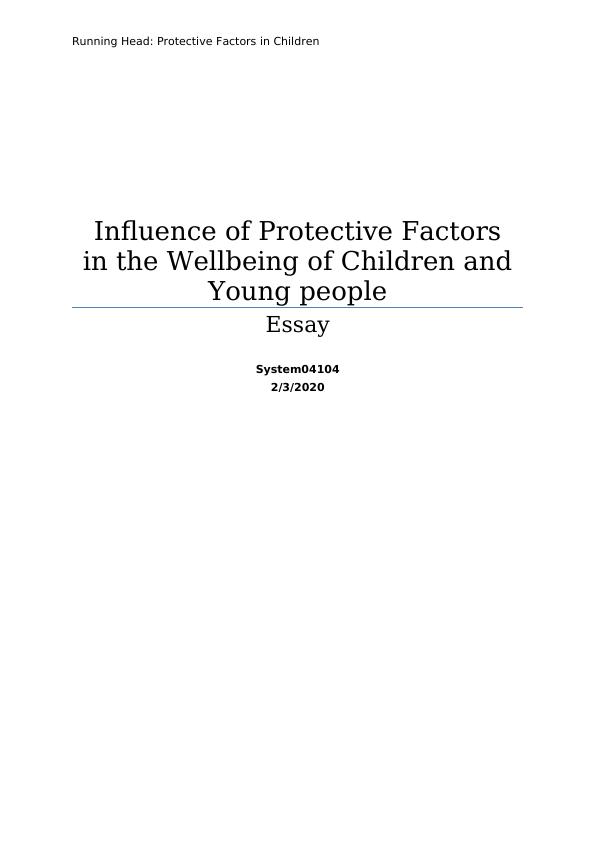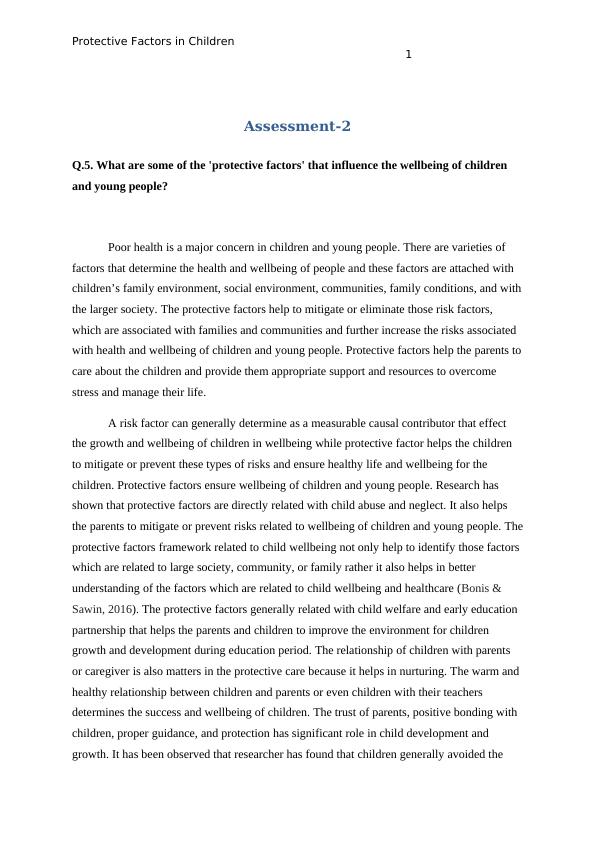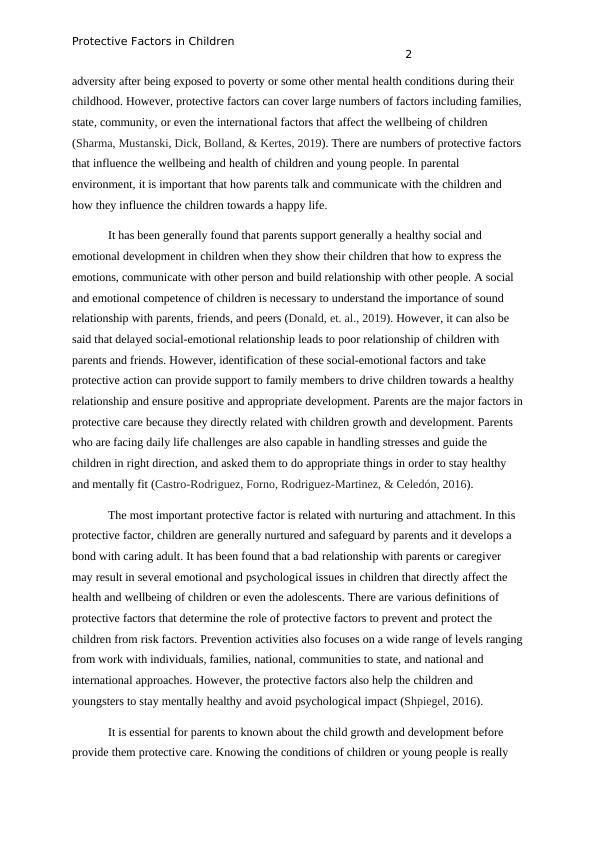Protective Factors in Children
Added on 2022-08-16
8 Pages2855 Words12 Views
Running Head: Protective Factors in Children
Influence of Protective Factors
in the Wellbeing of Children and
Young people
Essay
System04104
2/3/2020
Influence of Protective Factors
in the Wellbeing of Children and
Young people
Essay
System04104
2/3/2020

Protective Factors in Children
1
Assessment-2
Q.5. What are some of the 'protective factors' that influence the wellbeing of children
and young people?
Poor health is a major concern in children and young people. There are varieties of
factors that determine the health and wellbeing of people and these factors are attached with
children’s family environment, social environment, communities, family conditions, and with
the larger society. The protective factors help to mitigate or eliminate those risk factors,
which are associated with families and communities and further increase the risks associated
with health and wellbeing of children and young people. Protective factors help the parents to
care about the children and provide them appropriate support and resources to overcome
stress and manage their life.
A risk factor can generally determine as a measurable causal contributor that effect
the growth and wellbeing of children in wellbeing while protective factor helps the children
to mitigate or prevent these types of risks and ensure healthy life and wellbeing for the
children. Protective factors ensure wellbeing of children and young people. Research has
shown that protective factors are directly related with child abuse and neglect. It also helps
the parents to mitigate or prevent risks related to wellbeing of children and young people. The
protective factors framework related to child wellbeing not only help to identify those factors
which are related to large society, community, or family rather it also helps in better
understanding of the factors which are related to child wellbeing and healthcare (Bonis &
Sawin, 2016). The protective factors generally related with child welfare and early education
partnership that helps the parents and children to improve the environment for children
growth and development during education period. The relationship of children with parents
or caregiver is also matters in the protective care because it helps in nurturing. The warm and
healthy relationship between children and parents or even children with their teachers
determines the success and wellbeing of children. The trust of parents, positive bonding with
children, proper guidance, and protection has significant role in child development and
growth. It has been observed that researcher has found that children generally avoided the
1
Assessment-2
Q.5. What are some of the 'protective factors' that influence the wellbeing of children
and young people?
Poor health is a major concern in children and young people. There are varieties of
factors that determine the health and wellbeing of people and these factors are attached with
children’s family environment, social environment, communities, family conditions, and with
the larger society. The protective factors help to mitigate or eliminate those risk factors,
which are associated with families and communities and further increase the risks associated
with health and wellbeing of children and young people. Protective factors help the parents to
care about the children and provide them appropriate support and resources to overcome
stress and manage their life.
A risk factor can generally determine as a measurable causal contributor that effect
the growth and wellbeing of children in wellbeing while protective factor helps the children
to mitigate or prevent these types of risks and ensure healthy life and wellbeing for the
children. Protective factors ensure wellbeing of children and young people. Research has
shown that protective factors are directly related with child abuse and neglect. It also helps
the parents to mitigate or prevent risks related to wellbeing of children and young people. The
protective factors framework related to child wellbeing not only help to identify those factors
which are related to large society, community, or family rather it also helps in better
understanding of the factors which are related to child wellbeing and healthcare (Bonis &
Sawin, 2016). The protective factors generally related with child welfare and early education
partnership that helps the parents and children to improve the environment for children
growth and development during education period. The relationship of children with parents
or caregiver is also matters in the protective care because it helps in nurturing. The warm and
healthy relationship between children and parents or even children with their teachers
determines the success and wellbeing of children. The trust of parents, positive bonding with
children, proper guidance, and protection has significant role in child development and
growth. It has been observed that researcher has found that children generally avoided the

Protective Factors in Children
2
adversity after being exposed to poverty or some other mental health conditions during their
childhood. However, protective factors can cover large numbers of factors including families,
state, community, or even the international factors that affect the wellbeing of children
(Sharma, Mustanski, Dick, Bolland, & Kertes, 2019). There are numbers of protective factors
that influence the wellbeing and health of children and young people. In parental
environment, it is important that how parents talk and communicate with the children and
how they influence the children towards a happy life.
It has been generally found that parents support generally a healthy social and
emotional development in children when they show their children that how to express the
emotions, communicate with other person and build relationship with other people. A social
and emotional competence of children is necessary to understand the importance of sound
relationship with parents, friends, and peers (Donald, et. al., 2019). However, it can also be
said that delayed social-emotional relationship leads to poor relationship of children with
parents and friends. However, identification of these social-emotional factors and take
protective action can provide support to family members to drive children towards a healthy
relationship and ensure positive and appropriate development. Parents are the major factors in
protective care because they directly related with children growth and development. Parents
who are facing daily life challenges are also capable in handling stresses and guide the
children in right direction, and asked them to do appropriate things in order to stay healthy
and mentally fit (Castro-Rodriguez, Forno, Rodriguez-Martinez, & Celedón, 2016).
The most important protective factor is related with nurturing and attachment. In this
protective factor, children are generally nurtured and safeguard by parents and it develops a
bond with caring adult. It has been found that a bad relationship with parents or caregiver
may result in several emotional and psychological issues in children that directly affect the
health and wellbeing of children or even the adolescents. There are various definitions of
protective factors that determine the role of protective factors to prevent and protect the
children from risk factors. Prevention activities also focuses on a wide range of levels ranging
from work with individuals, families, national, communities to state, and national and
international approaches. However, the protective factors also help the children and
youngsters to stay mentally healthy and avoid psychological impact (Shpiegel, 2016).
It is essential for parents to known about the child growth and development before
provide them protective care. Knowing the conditions of children or young people is really
2
adversity after being exposed to poverty or some other mental health conditions during their
childhood. However, protective factors can cover large numbers of factors including families,
state, community, or even the international factors that affect the wellbeing of children
(Sharma, Mustanski, Dick, Bolland, & Kertes, 2019). There are numbers of protective factors
that influence the wellbeing and health of children and young people. In parental
environment, it is important that how parents talk and communicate with the children and
how they influence the children towards a happy life.
It has been generally found that parents support generally a healthy social and
emotional development in children when they show their children that how to express the
emotions, communicate with other person and build relationship with other people. A social
and emotional competence of children is necessary to understand the importance of sound
relationship with parents, friends, and peers (Donald, et. al., 2019). However, it can also be
said that delayed social-emotional relationship leads to poor relationship of children with
parents and friends. However, identification of these social-emotional factors and take
protective action can provide support to family members to drive children towards a healthy
relationship and ensure positive and appropriate development. Parents are the major factors in
protective care because they directly related with children growth and development. Parents
who are facing daily life challenges are also capable in handling stresses and guide the
children in right direction, and asked them to do appropriate things in order to stay healthy
and mentally fit (Castro-Rodriguez, Forno, Rodriguez-Martinez, & Celedón, 2016).
The most important protective factor is related with nurturing and attachment. In this
protective factor, children are generally nurtured and safeguard by parents and it develops a
bond with caring adult. It has been found that a bad relationship with parents or caregiver
may result in several emotional and psychological issues in children that directly affect the
health and wellbeing of children or even the adolescents. There are various definitions of
protective factors that determine the role of protective factors to prevent and protect the
children from risk factors. Prevention activities also focuses on a wide range of levels ranging
from work with individuals, families, national, communities to state, and national and
international approaches. However, the protective factors also help the children and
youngsters to stay mentally healthy and avoid psychological impact (Shpiegel, 2016).
It is essential for parents to known about the child growth and development before
provide them protective care. Knowing the conditions of children or young people is really

End of preview
Want to access all the pages? Upload your documents or become a member.
Related Documents
Assignment about Child Abuselg...
|6
|797
|53
Supporting Child Health and Wellbeing: Factors, Effects, and Strategieslg...
|1
|785
|208
THE EARLY CHILDHOODlg...
|12
|3354
|39
Counselling Children and Adolescents: Case Study on Mental Health and Wellbeinglg...
|10
|2703
|402
Critical Analysis of Children's Health and Wellbeing Leafletslg...
|9
|2394
|411
Child Care Protection Actlg...
|11
|2985
|64